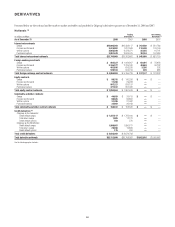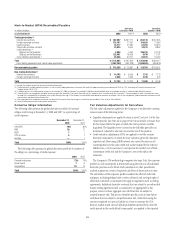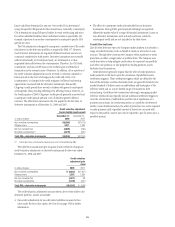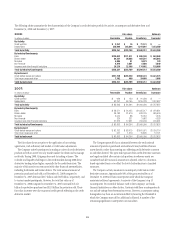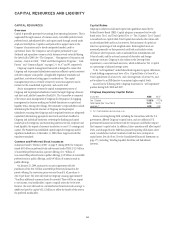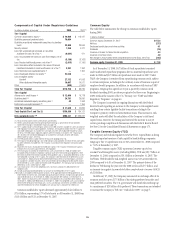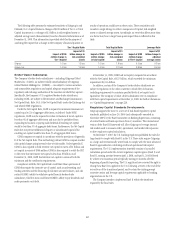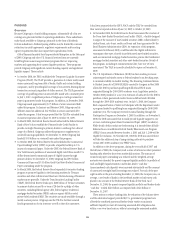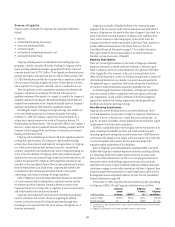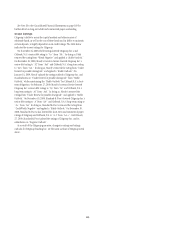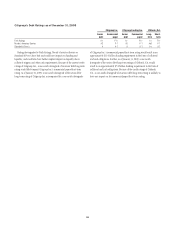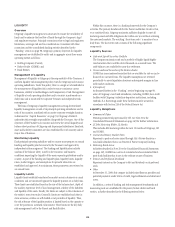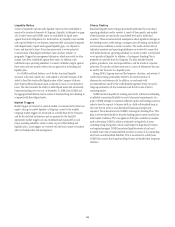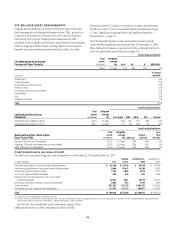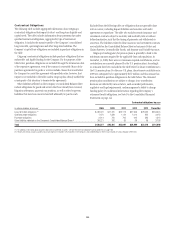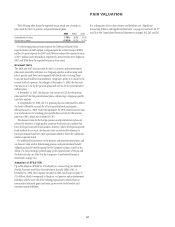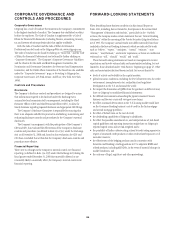Citibank 2008 Annual Report Download - page 104
Download and view the complete annual report
Please find page 104 of the 2008 Citibank annual report below. You can navigate through the pages in the report by either clicking on the pages listed below, or by using the keyword search tool below to find specific information within the annual report.FUNDING
Overview
Because Citigroup is a bank holding company, substantially all of its net
earnings are generated within its operating subsidiaries. These subsidiaries
make funds available to Citigroup, primarily in the form of dividends.
Certain subsidiaries’ dividend-paying abilities may be limited by covenant
restrictions in credit agreements, regulatory requirements and/or rating-
agency requirements that also impact their capitalization levels.
Global financial markets faced unprecedented disruption in the latter part
of 2008. Citigroup and other U.S. financial services firms are currently
benefiting from numerous government programs that are improving
markets and supporting their current liquidity positions. These programs
provide Citigroup with significant current funding capacity and significant
liquidity support. These include:
• In October 2008, the FDIC established the Temporary Liquidity Guarantee
Program (TLGP). The TLGP provides a guarantee of certain newly issued
senior unsecured long-term debt of banks, thrifts and certain holding
companies, and by providing full coverage of non-interest-bearing deposit
transaction accounts, regardless of dollar amount. The TLGP guarantees
coverage of qualifying senior unsecured debt issued with a maturity prior
to July 1, 2012. A significant portion of Citigroup’s existing commercial
paper is guaranteed under this program. In addition, in December 2008,
Citigroup issued approximately $5.75 billion of senior unsecured debt
under this program. In January and February 2009, Citigroup and its
affiliates issued an additional $14.9 billion in senior unsecured debt
under the program. It has been proposed that the TLGP be extended from
its current expiration date of June 30, 2009 to October 30, 2009.
• In March 2008, the Federal Reserve Board authorized the Federal Reserve
Bank of New York to establish the Primary Dealer Credit Facility to
provide overnight financing to primary dealers in exchange for a broad
range of collateral. Citigroup utilizes this program to supplement its
secured financing capabilities. On December 31, 2008, Citigroup had
funded $13.8 billion on a secured basis under this program.
• In October 2008, the Federal Reserve Board established the Commercial
Paper Funding Facility (CPFF) to provide a liquidity backstop to U.S.
issuers of commercial paper. Under the CPFF, the Federal Reserve Bank of
New York finances purchases of unsecured highly rated three-month U.S.
dollar-denominated commercial paper of eligible issuers through
primary dealers. On December 31, 2008, Citigroup had $9.0 billion
Commercial Paper and $3.3 billion Credit Card Asset-Backed Commercial
Paper outstanding under the program.
• In March 2008, the Federal Reserve Board expanded its securities lending
program to promote liquidity in the financing markets for Treasury
securities and other collateral and thus foster the functioning of financial
markets more generally. Under the Term Securities Lending Facility
(TSLF), the Federal Reserve lends up to $200 billion of Treasury securities
to primary dealers secured for a term of 28 days by a pledge of other
securities, including federal agency debt, federal agency residential-
mortgage-backed securities (MBS) and non-agency AAA/Aaa-rated
private-label residential MBS. The securities are made available through a
weekly auction process. Citigroup uses the TSLF to facilitate secured
funding transactions for its inventory as well as that of its customers.
It has been proposed that the CPFF, PDCF and the TSLF be extended from
their current expiration dates of June 30, 2009 to October 30, 2009.
• In November 2008, the Federal Reserve Board announced the creation of
the Term Asset-Backed Securities Loan Facility (TALF), a facility designed
to support the issuance of asset-backed securities (ABS) collateralized by
student loans, auto loans, credit card loans and loans guaranteed by the
Small Business Administration (SBA). An expansion of this program,
announced in February 2009, could broaden the eligible collateral to
encompass other types of newly issued AAA-rated asset-backed securities,
such as commercial mortgage-backed securities, private-label residential
mortgage-backed securities and other asset-backed securities. Details of
this program, including its commencement date, have not yet been
announced. The TALF is currently scheduled to expire on December 31,
2009.
• The U.S. Department of Education (DOE) has been working to ensure
uninterrupted and timely access to Federal student loans by taking steps
to maintain stability in student lending. The Ensuring Continued Access
to Student Loans Act of 2008 (ECASLA) enacted by Congress in May 2008
allows the DOE to purchase qualifying Stafford and PLUS Loans
originated during the 2003-2009 academic years. Legislation passed in
October 2008 provides for a one year extension of authority for the DOE to
purchase certain guaranteed student loans as defined under ECASLA
through the 2009-2010 academic year. On July 3, 2008, the Company
filed a required Notice of Intent to Participate with the Department under
a program limited to qualifying loans originated during the 2008-2009
academic year. The Company received its initial funding through the
Participation Program on December 5, 2008. In addition, on November 8,
2008, the DOE announced that it would provide liquidity support to one
or more conforming Asset-Based Commercial Paper (ABCP) conduit(s).
While details of this conduit are forthcoming, it is intended that all fully-
disbursed non-consolidation Federal Family Education Loan Program
(FFELP) loans awarded between October 1, 2003 and July 1, 2009 will be
eligible for inclusion. On November 20, 2008 the DOE announced that it
will take the additional step of using existing authority to purchase
certain 2007-2008 academic year FFELP loans.
In addition to the above programs, during the second half of 2007 and
the full year of 2008, the Company took a series of actions to reduce potential
funding risks related to short-term market dislocations. The amount of
commercial paper outstanding was reduced and the weighted-average
maturity was extended, the parent company liquidity portfolio (a portfolio of
cash and highly liquid securities) and broker-dealer “cash box”
(unencumbered cash deposits) were increased substantially and the amount
of unsecured overnight bank borrowings was reduced. For each of the past
eight months in the period ending December 31, 2008, the Company was, on
average, a net lender of funds in the interbank market or had excess cash
placed in its account at the Federal Reserve Bank of New York. As of
December 31, 2008, the parent company liquidity portfolio and broker-dealer
“cash box” totaled $66.8 billion as compared with $24.2 billion at
December 31, 2007.
These actions to reduce funding risks, the reduction of the balance sheet
and the substantial support provided by U.S. government programs have
allowed the combined parent and broker-dealer entities to maintain
sufficient liquidity to meet all maturing unsecured debt obligations due
within a one-year time horizon, without accessing the unsecured markets.
98




